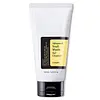What's inside
What's inside
 Key Ingredients
Key Ingredients

No key ingredients
 Benefits
Benefits

 Concerns
Concerns

 Ingredients Side-by-side
Ingredients Side-by-side

Water
Skin ConditioningGlycerin
HumectantLauramide DEA
Potassium Cocoyl Glycinate
Tea-Cocoyl Glutamate
CleansingSodium Methyl Cocoyl Taurate
CleansingAcrylates/C10-30 Alkyl Acrylate Crosspolymer
Emulsion StabilisingChlorphenesin
AntimicrobialEthylhexylglycerin
Skin ConditioningPEG-160 Sorbitan Triisostearate
CleansingSodium Chloride
MaskingCaprylyl Glycol
EmollientStyrene/Acrylates Copolymer
Onsen-Sui
Citrus Aurantium Bergamia Fruit Oil
MaskingHydrolyzed Collagen Extract
Skin ProtectingCaprylhydroxamic Acid
Rosmarinus Officinalis Leaf Oil
MaskingCitrus Aurantifolia Oil
CleansingDisodium EDTA
Betaine
HumectantButylene Glycol
Humectant1,2-Hexanediol
Skin ConditioningSodium Methyltaurate
Skin ConditioningQuillaja Saponaria Wood Extract
Skin ConditioningSapindus Mukorossi Fruit Extract
Skin ConditioningHydrolyzed Elastin
EmollientYucca Vera Leaf/Root Extract
MaskingSodium Benzoate
MaskingWater, Glycerin, Lauramide DEA, Potassium Cocoyl Glycinate, Tea-Cocoyl Glutamate, Sodium Methyl Cocoyl Taurate, Acrylates/C10-30 Alkyl Acrylate Crosspolymer, Chlorphenesin, Ethylhexylglycerin, PEG-160 Sorbitan Triisostearate, Sodium Chloride, Caprylyl Glycol, Styrene/Acrylates Copolymer, Onsen-Sui, Citrus Aurantium Bergamia Fruit Oil, Hydrolyzed Collagen Extract, Caprylhydroxamic Acid, Rosmarinus Officinalis Leaf Oil, Citrus Aurantifolia Oil, Disodium EDTA, Betaine, Butylene Glycol, 1,2-Hexanediol, Sodium Methyltaurate, Quillaja Saponaria Wood Extract, Sapindus Mukorossi Fruit Extract, Hydrolyzed Elastin, Yucca Vera Leaf/Root Extract, Sodium Benzoate
Water
Skin ConditioningAcrylates Copolymer
Butylene Glycol
HumectantGlycerin
HumectantDisodium Laureth Sulfosuccinate
CleansingSodium Cocoyl Isethionate
Cleansing1,2-Hexanediol
Skin ConditioningCoco-Glucoside
CleansingLauryl Betaine
CleansingSnail Secretion Filtrate
Skin ConditioningArginine
MaskingTromethamine
BufferingPotassium Cocoyl Glycinate
Parfum
MaskingCarbomer
Emulsion StabilisingSodium Chloride
MaskingEthylhexylglycerin
Skin ConditioningAcrylates/C10-30 Alkyl Acrylate Crosspolymer
Emulsion StabilisingSodium Polyacrylate
AbsorbentDisodium EDTA
Water, Acrylates Copolymer, Butylene Glycol, Glycerin, Disodium Laureth Sulfosuccinate, Sodium Cocoyl Isethionate, 1,2-Hexanediol, Coco-Glucoside, Lauryl Betaine, Snail Secretion Filtrate, Arginine, Tromethamine, Potassium Cocoyl Glycinate, Parfum, Carbomer, Sodium Chloride, Ethylhexylglycerin, Acrylates/C10-30 Alkyl Acrylate Crosspolymer, Sodium Polyacrylate, Disodium EDTA
 Reviews
Reviews

Ingredients Explained
These ingredients are found in both products.
Ingredients higher up in an ingredient list are typically present in a larger amount.
1,2-Hexanediol is a synthetic liquid and another multi-functional powerhouse.
It is a:
- Humectant, drawing moisture into the skin
- Emollient, helping to soften skin
- Solvent, dispersing and stabilizing formulas
- Preservative booster, enhancing the antimicrobial activity of other preservatives
Acrylates/C10-30 Alkyl Acrylate Crosspolymer is a synthetic polymer. It is used to thicken and improve the texture of products. Due to its properties, it can prevent water and oil ingredients from separating.
Butylene Glycol (or BG) is used within cosmetic products for a few different reasons:
Overall, Butylene Glycol is a safe and well-rounded ingredient that works well with other ingredients.
Though this ingredient works well with most skin types, some people with sensitive skin may experience a reaction such as allergic rashes, closed comedones, or itchiness.
Learn more about Butylene GlycolDisodium EDTA plays a role in making products more stable by aiding other preservatives.
It is a chelating agent, meaning it neutralizes metal ions that may be found in a product.
Disodium EDTA is a salt of edetic acid and is found to be safe in cosmetic ingredients.
Learn more about Disodium EDTAEthylhexylglycerin (we can't pronounce this either) is commonly used as a preservative and skin softener. It is derived from glyceryl.
You might see Ethylhexylglycerin often paired with other preservatives such as phenoxyethanol. Ethylhexylglycerin has been found to increase the effectiveness of these other preservatives.
Glycerin is already naturally found in your skin. It helps moisturize and protect your skin.
A study from 2016 found glycerin to be more effective as a humectant than AHAs and hyaluronic acid.
As a humectant, it helps the skin stay hydrated by pulling moisture to your skin. The low molecular weight of glycerin allows it to pull moisture into the deeper layers of your skin.
Hydrated skin improves your skin barrier; Your skin barrier helps protect against irritants and bacteria.
Glycerin has also been found to have antimicrobial and antiviral properties. Due to these properties, glycerin is often used in wound and burn treatments.
In cosmetics, glycerin is usually derived from plants such as soybean or palm. However, it can also be sourced from animals, such as tallow or animal fat.
This ingredient is organic, colorless, odorless, and non-toxic.
Glycerin is the name for this ingredient in American English. British English uses Glycerol/Glycerine.
Learn more about GlycerinPotassium Cocoyl Glycinate is an amino acid-based surfactant and cleaning agent. This ingredient can be derived from animals or plants. It may also be synthetically created from fatty acids of the coconut and glycine.
Potassium Cocoyl Glycinate is a gentle surfactant. Surfactants help gather the dirt, oil, and other pollutants from your skin to be rinsed away. It is a mild cleanser and naturally produces foam.
Chances are, you eat sodium chloride every day. Sodium Chloride is also known as table salt.
This ingredient has many purposes in skincare: thickener, emulsifier, and exfoliator.
You'll most likely find this ingredient in cleansers where it is used to create a gel-like texture. As an emulsifier, it also prevents ingredients from separating.
There is much debate on whether this ingredient is comedogenic. The short answer - comedogenic ratings don't tell the whole story. Learn more about comegodenic ratings here.
The concensus about this ingredient causing acne seems to be divided. Research is needed to understand if this ingredient does cause acne.
Scrubs may use salt as the primary exfoliating ingredient.
Learn more about Sodium ChlorideWater. It's the most common cosmetic ingredient of all. You'll usually see it at the top of ingredient lists, meaning that it makes up the largest part of the product.
So why is it so popular? Water most often acts as a solvent - this means that it helps dissolve other ingredients into the formulation.
You'll also recognize water as that liquid we all need to stay alive. If you see this, drink a glass of water. Stay hydrated!
Learn more about Water